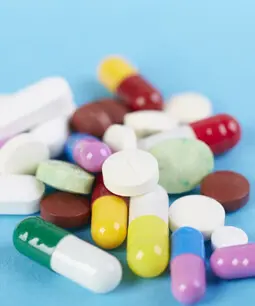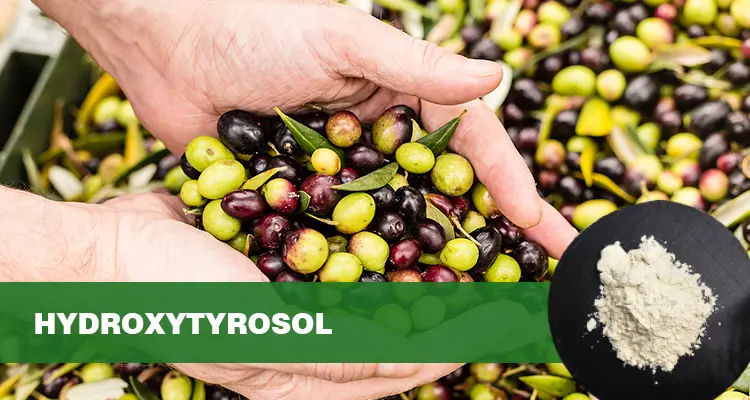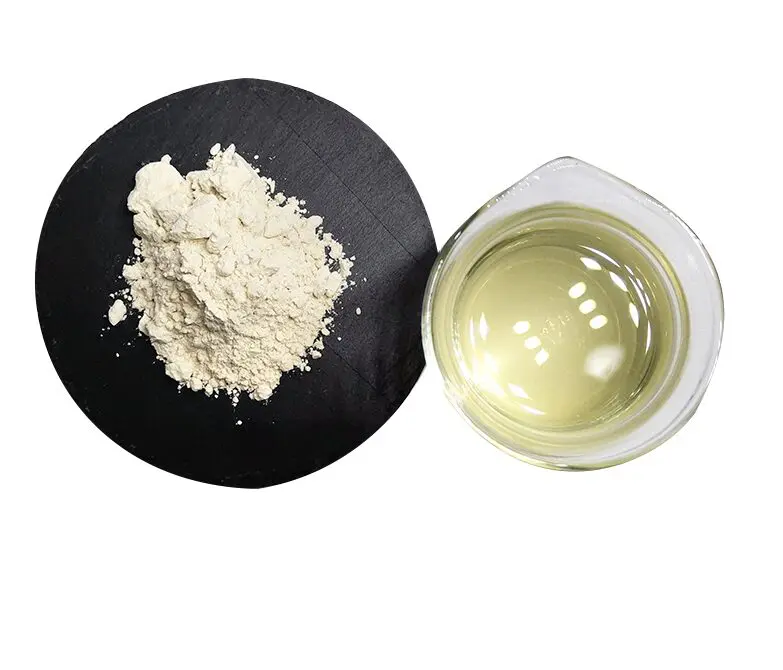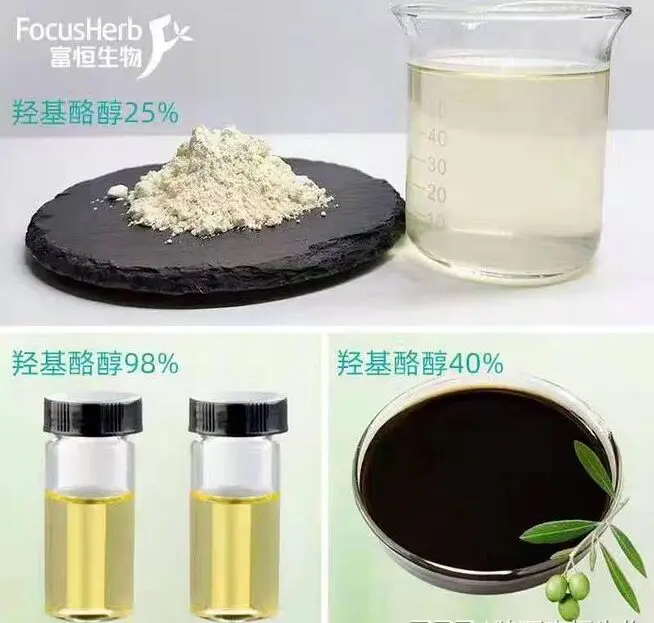Hydroxytyrosol may be unfamiliar to many, but its benefits are significant. It’s the core active ingredient in olive oil and olive leaf extract, chemically known as 3,4-dihydroxyphenylethanol. Chemically, the hydroxytyrosol molecule contains a catechol group. This unique structure gives it exceptional hydrogen-donating capacity, making it one of nature’s most potent antioxidant polyphenols.
Hydroxytyrosol is unevenly distributed throughout olives. Its concentration in olive leaves is relatively high, ranging from 1.5% to 3%. In olive oil, hydroxytyrosol primarily exists as an ester. When we consume olive oil or products containing olive leaf extract, these esters undergo a series of metabolic processes in the intestines, ultimately releasing free hydroxytyrosol, which then exerts its various health benefits. For example, people in the Mediterranean region, who consume a high amount of olive oil in their diet, have a relatively low incidence of cardiovascular disease, partly due to the antioxidant and cardiovascular protective properties of hydroxytyrosol in olive oil.
As a small, fat-soluble ingredient, hydroxytyrosol offers unique bioavailability advantages. It efficiently penetrates cell membranes, like a tiny key, easily unlocking the cell’s door and gaining access to its inner workings. Furthermore, hydroxytyrosol can cross the blood-brain barrier, enabling it to exert antioxidant and neuroprotective effects in the brain, which is crucial for preventing and improving certain neurological diseases.
Research has shown that hydroxytyrosol accumulates in target sites such as the dermis and mitochondrial membranes. Compared to vitamin C, its bioavailability is over three times higher. Furthermore, hydroxytyrosol does not carry the dose-dependent toxicity risk common with traditional antioxidants, meaning that when used appropriately, it can provide antioxidant protection more safely. When added to skincare products, hydroxytyrosol is rapidly absorbed into the dermis, scavenging free radicals, reducing oxidative damage, and delaying skin aging, without the risk of adverse reactions related to dosage.
 Core Antioxidant Mechanism: A Multi-Dimensional Free Radical Defense System
Core Antioxidant Mechanism: A Multi-Dimensional Free Radical Defense System
The “Molecular Sponge” Effect of Free Radical Scavenging
1. Broad-Spectrum Free Radical Capturing Ability
Free radicals are ubiquitous in our environment, like restless little monsters, constantly threatening cellular health. Toxic free radicals such as superoxide anions (O₂⁻), hydroxyl radicals (・OH), and peroxynitrites (ONOO⁻) are the primary culprits of cellular oxidative damage. Hydroxytyrosol, like a valiant “guardian,” exhibits powerful free radical scavenging capabilities thanks to its unique molecular structure.
Hydroxytyrosol’s catechol structure is its “secret weapon” against free radicals. This structure can simultaneously donate two active hydrogen atoms. Upon encountering a free radical, hydroxytyrosol rapidly donates its active hydrogen atoms, stabilizing the free radical and thereby interrupting the lipid peroxidation chain reaction. This reaction acts like a shackle on the free radical, preventing it from further damaging biomolecules such as lipids, proteins, and DNA within the cell. Compared to the traditional antioxidant vitamin E, hydroxytyrosol exhibits significantly higher free radical scavenging efficiency, with its IC₅₀ value being 40% lower than that of vitamin E. This means that under the same conditions, hydroxytyrosol can achieve the same free radical scavenging effect as vitamin E at a lower concentration. In a UV-induced skin oxidation model, hydroxytyrosol also performed remarkably well, reducing intracellular reactive oxygen species (ROS) levels by 65%, effectively mitigating UV-induced oxidative damage to skin cells.
2. Activation of Endogenous Antioxidant Pathways
In addition to directly scavenging free radicals, hydroxytyrosol can also activate endogenous antioxidant pathways within cells, fundamentally boosting their antioxidant capacity and essentially injecting a powerful boost into the cell’s antioxidant defense system.
The Nrf2/ARE signaling pathway is a crucial intracellular anti-oxidative stress response pathway. When cells are exposed to oxidative stress, Nrf2 is activated and translocates from the cytoplasm to the nucleus, where it binds to the antioxidant response element (ARE), triggering the expression of a series of antioxidant enzyme genes. Hydroxytyrosol can activate the Nrf2/ARE signaling pathway, upregulating the expression of antioxidant enzymes such as superoxide dismutase (SOD) and glutathione peroxidase (GSH-Px) by 30%-50%. These antioxidant enzymes act as intracellular “cleaners,” promptly removing free radicals generated within the cell and maintaining redox balance.
Hydroxytyrosol can also restore intracellular glutathione (GSH) levels. GSH is a key antioxidant in cells that directly participates in free radical scavenging reactions and regenerates other antioxidants, such as vitamins C and E. In a H₂O₂-damaged hepatocyte model, hydroxytyrosol reduced GSH depletion by 70%, effectively protecting hepatocytes from oxidative damage and maintaining normal liver function.
Targeted Mitochondrial Protection: From Energy Factories to Aging Regulation
1. Maintaining Respiratory Chain Complex Activity
Mitochondria, known as the “energy factories” of the cell, are crucial for normal cellular function. It produces ATP, the energy molecule needed by cells, through oxidative phosphorylation reactions via respiratory chain complexes. However, during this process, mitochondria also produce a large number of free radicals. When excessive free radicals accumulate, they damage mitochondria, impairing their function and accelerating cellular aging. Hydroxytyrosol acts as a “guardian” of mitochondria. It can reduce the generation of free radicals caused by electron leakage by increasing the activity of mitochondrial complexes I and II. In vitro experiments have shown that hydroxytyrosol treatment increased the activity of mitochondrial complexes I and II by 25%-35%, facilitating smoother electron transfer in the respiratory chain and reducing the generation of free radicals. Furthermore, hydroxytyrosol promotes the expression of PGC-1α protein, increasing its peak concentration by 205%. PGC-1α is a key regulator of cellular energy metabolism, inducing mitochondrial biogenesis and increasing the number and quality of mitochondria. In aged fibroblasts, hydroxytyrosol treatment increased mitochondrial DNA copy number by 40%, indicating that the number of mitochondria is replenished, improving the cell’s energy supply capacity and thus slowing the aging process.
2. Blocking Membrane Lipid Peroxidation
The mitochondrial membrane is composed of a lipid bilayer. These lipids are susceptible to free radical attack, leading to peroxidation reactions and damage to the membrane’s structure and function. Malondialdehyde (MDA) is one of the main products of lipid peroxidation, and its content reflects the extent of membrane lipid peroxidation.
Hydroxytyrosol, a lipid-soluble antioxidant, can be incorporated into the mitochondrial membrane lipid bilayer, forming a protective layer on the membrane. It inhibits the production of peroxidation products such as MDA, reducing MDA levels by 55%, effectively blocking membrane lipid peroxidation and maintaining the stability of mitochondrial membrane potential.
In the Caenorhabditis elegans model, researchers have found that when mitochondria are damaged, the lifespan of the nematodes is significantly shortened. However, treatment with hydroxytyrosol reduced the rate of lifespan reduction caused by mitochondrial damage by 30%. This strongly demonstrates that hydroxytyrosol has a positive impact on the aging process by protecting the mitochondrial membrane and maintaining mitochondrial function, providing strong support for delaying aging.
Multi-target anti-aging action network
Cellular Level: The Molecular Switch that Delays Aging
1. Telomeres and DNA Damage Protection
Telomeres, like the “safety caps” at the ends of chromosomes, are closely linked to cellular aging. As cells divide, telomeres gradually shorten. When telomere shortening reaches a certain level, cells enter a state of senescence. DNA damage is another major factor in cellular aging. Factors such as oxidative stress can cause DNA damage, impairing normal cellular function.
Hydroxytyrosol plays a key role in protecting telomeres and DNA. It inhibits the production of 8-OHdG, a marker of DNA oxidative damage, reducing its damage to DNA. Studies have shown that hydroxytyrosol can reduce 8-OHdG production by 45%, thereby slowing the rate of telomere shortening. In human umbilical cord mesenchymal stem cells, hydroxytyrosol increased telomerase activity by 22%, indicating that cells are better able to maintain telomere length. With increased telomerase activity, the number of cell passages increased by 25%, effectively delaying the process of replicative aging. This is like putting a lock on the cell’s “lifespan clock,” slowing down the rate of cellular aging.
2. Regulating the Autophagy-Apoptosis Balance
Autophagy and apoptosis are two important physiological processes within cells, crucial for maintaining cellular homeostasis and health. Autophagy acts as a cellular “cleaner,” removing waste from aging organelles, misfolded proteins, and other debris, keeping cells clean and functioning normally. Apoptosis, on the other hand, is a form of programmed cell death. When cells are severely damaged or beyond repair, they initiate apoptosis to prevent further damage to the body.
During cellular aging, the balance between autophagy and apoptosis is disrupted. Hydroxytyrosol can induce autophagy by activating the AMPK/mTOR pathway, promoting the clearance of senescence-associated β-galactosidase (SA-β-gal)-positive cells by up to 35%. Hydroxytyrosol also inhibits the expression of the pro-apoptotic protein Bax, reducing the occurrence of apoptosis. In UV-damaged keratinocytes, hydroxytyrosol reduced the apoptosis rate by 60%, demonstrating its ability to effectively protect cells, maintain the balance between autophagy and apoptosis, and delay cellular aging.
Skin Anti-Aging: Three-Dimensional Repair from the Dermis to the Epidermis
1. Collagen Network Remodeling and Wrinkle Improvement
Skin elasticity and firmness primarily depend on collagen fibers in the dermis. With aging and environmental influences such as UV exposure and pollution, collagen in the skin gradually depletes, damaging collagen fibers and leading to aging symptoms such as sagging and wrinkles.
Hydroxytyrosol plays a crucial role in remodeling the skin’s collagen network. It stimulates fibroblast type I collagen mRNA expression, increasing it by 60%, thereby increasing the density of collagen fibers in the dermis. In a double-blind clinical trial, 8 weeks of hydroxytyrosol supplementation increased skin elasticity by 28% and reduced the depth of forehead wrinkles by 15%. This is like injecting a “tightening force” into sagging skin, restoring its elasticity and reducing the appearance of wrinkles. Hydroxytyrosol also inhibits the activity of matrix metalloproteinases (MMP-1/MMP-3) by 40%. These MMPs are the primary culprits in collagen fibril breakdown. By inhibiting their activity, hydroxytyrosol blocks UV-induced collagen fibril breakdown. In a mouse model of photoaging, hydroxytyrosol reduced collagen degradation products in the dermis by 50%, effectively protecting the skin’s collagen network and slowing the aging process.
2. Breaking the Inflammation-Oxidation Vicious Cycle
Skin inflammation and oxidative stress are closely linked, mutually reinforcing each other and forming a vicious cycle. Inflammation leads to increased oxidative stress, generating a large number of free radicals, which in turn further exacerbate the inflammatory response, damage skin cells, and accelerate skin aging.
Hydroxytyrosol can inhibit the NF-κB pathway, reducing the release of pro-inflammatory cytokines such as IL-6 and TNF-α by 55%. This acts like a pause button on the inflammatory response, alleviating inflammatory skin conditions such as acne and seborrheic dermatitis. Hydroxytyrosol also reduces histamine-induced vascular permeability, alleviating skin redness and sensitivity, and reducing the area of erythema by 30%. By interrupting the vicious cycle of inflammation and oxidation, hydroxytyrosol provides a healthy environment for the skin, helping to delay skin aging.
3. Synergistic Effects of Whitening and Moisturizing
Skin whitening and moisturizing are important aspects of skin health and beauty. Excessive melanin production can lead to dullness and dark spots, while dehydration can cause dryness, roughness, and a loss of radiance.
Hydroxytyrosol has a synergistic effect in whitening and moisturizing. Regarding whitening, it competitively binds to the active site of tyrosinase, inhibiting melanin synthesis and reducing tyrosinase activity by 40%. In a B16 melanoma cell model, hydroxytyrosol reduced melanin production by 65%, resulting in brighter, more translucent skin. In terms of moisturizing, hydroxytyrosol’s small molecular structure allows it to penetrate deep into the stratum corneum, increasing the expression of the aquaporin AQP3 by 35%. Aquaporins act like the skin’s “water pipelines.” Increased expression of aquaporins can increase skin hydration by 22% and reduce transepidermal water loss (TEWL) by 18%, keeping skin constantly hydrated.
Scientific Application Scenarios and Supplementation Strategies
Functional Foods and Dietary Supplements
1. Natural Sources and High-Efficiency Formulations
In their pursuit of health, more and more people are turning to functional foods and dietary supplements. Hydroxytyrosol, a natural antioxidant, is attracting significant attention for its sources and formulations.
Olive oil, especially extra virgin olive oil, is a key natural source of hydroxytyrosol, containing approximately 0.2-0.5 mg of hydroxytyrosol per kilogram. Consuming a moderate amount of olive oil in daily diets not only adds a unique flavor to dishes but also allows for the intake of hydroxytyrosol and its health benefits. For example, using extra virgin olive oil instead of regular cooking oil in salad vegetables preserves the nutrients while allowing for easy intake of hydroxytyrosol.
Olive leaf extract is a more concentrated source of hydroxytyrosol. Standardized olive leaf extract products can contain as much as 50-98% hydroxytyrosol. To enhance the bioavailability of hydroxytyrosol, researchers have employed nanoliposomal encapsulation technology. This technology acts like an invisible protective layer around hydroxytyrosol, allowing it to be better absorbed and utilized by the body once it enters. Its bioavailability is three times higher than traditional formulations.
For those seeking to consume hydroxytyrosol through dietary supplements, the recommended daily dose is 50-200 mg, which is roughly equivalent to 10-40 grams of olive leaf extract. When choosing a supplement, pay attention to the product’s ingredient list and production process, choosing one that utilizes advanced technology and offers reliable quality to ensure adequate hydroxytyrosol intake.
2. Suitable for Specific Populations
Different people have different physical conditions and needs, and hydroxytyrosol supplementation has specific benefits and suitable solutions for certain populations.
For those with dyslipidemia, which is a major risk factor for cardiovascular disease, an increase in oxidized low-density lipoprotein (ox-LDL) exacerbates the progression of atherosclerosis. Studies have found that a daily supplement of 100 mg of hydroxytyrosol can significantly reduce the level of ox-LDL oxidation by up to 25%. To further enhance cardiovascular protection, it is recommended to use hydroxytyrosol in conjunction with omega-3 supplements. Omega-3s are unsaturated fatty acids that can lower blood lipids and reduce inflammation. Working in conjunction with hydroxytyrosol, they can support cardiovascular health in multiple ways. For example, some fish oil supplements are rich in omega-3s. People with dyslipidemia can supplement with hydroxytyrosol and fish oil under a doctor’s guidance to improve their lipid profile and reduce the risk of cardiovascular disease.
For those with UV sensitivity, UV rays are one of the main external factors contributing to skin aging and damage. These individuals are more susceptible to UV damage, resulting in skin erythema and sunburn. Supplementing with 50 mg of hydroxytyrosol two hours before UV exposure, combined with a 0.5% hydroxytyrosol topical preparation, can reduce UVB-induced erythema by 40%. This is like putting on an invisible sunscreen, providing additional protection for those with UV sensitivity. Before outdoor activities, these individuals can take supplements containing hydroxytyrosol and apply sunscreen or skincare products containing hydroxytyrosol to effectively mitigate UV damage and maintain skin health.
Innovative Applications in Skincare Products
1. Active Ingredient Combinations
In the skincare market, hydroxytyrosol has become a favorite among many brands due to its outstanding antioxidant and anti-aging properties. To further enhance its effectiveness, researchers are continuously exploring combinations of hydroxytyrosol with other active ingredients.
In anti-wrinkle and firming formulas, combining 0.5%-2% hydroxytyrosol with 0.1% retinol can produce surprising synergistic effects. Retinol is a classic anti-wrinkle ingredient that promotes skin cell renewal and increases collagen production. The combined effect of hydroxytyrosol and retinol can boost collagen production by up to 1.8 times that of a single dose, while also reducing the potential irritation caused by retinol. They’re like a tacitly matched pair, each leveraging its own strengths while also complementing the other’s shortcomings. For consumers seeking firmer skin and wrinkle reduction, choosing skincare products containing this complex ingredient can more effectively achieve these anti-wrinkle and firming goals.
In a sunscreen booster formula, adding 0.3% hydroxytyrosol to a physical sunscreen neutralizes the free radicals generated by the sunscreen itself, increasing the sunscreen’s photostability by 30%. We all know that sun protection is a crucial part of skincare, and while sunscreen absorbs UV rays, it also generates free radicals, which can damage the skin. The addition of hydroxytyrosol acts like a protective shield for the sunscreen, enhancing its effectiveness while also reducing potential skin damage. When choosing a sunscreen, consider whether it contains hydroxytyrosol to achieve optimal sun protection and skincare benefits.
2. Clinically Proven Golden Concentration
The concentration of hydroxytyrosol in skincare products is crucial to its effectiveness. After extensive clinical research, researchers have identified the optimal concentration for optimal hydroxytyrosol performance in skincare products.
A cream containing 1% hydroxytyrosol increased the content of glycosaminoglycans (GAGs) in the dermis by 12% after four weeks of continuous use, effectively improving skin plumpness. Glycosaminoglycans are an important component of the skin’s extracellular matrix, helping to retain moisture and maintain firmness and elasticity. This cream injects a youthful energy into the skin, restoring its radiance. For those with dry, inelastic skin, choosing a cream containing 1% hydroxytyrosol and using it consistently for a period of time will yield noticeable improvements.
In a facial mask, a 0.8% concentration of hydroxytyrosol can increase the water content of the stratum corneum by 40% within 30 minutes, providing immediate repair. Facial masks are a skincare product that quickly replenishes nutrients and moisture. A 0.8% hydroxytyrosol mask is like a timely rain for the skin, instantly providing ample moisture and alleviating dryness and discomfort. When skin is dry and tired, using a mask containing 0.8% hydroxytyrosol can quickly restore moisture and vitality.
Research Frontiers and Future Outlook
Exploring New Targets for Disease Prevention
In medical research, hydroxytyrosol is emerging as a key molecule in the exploration of new targets for disease prevention.
A Phase II clinical study for Alzheimer’s disease has brought us exciting news. The study showed that hydroxytyrosol can reduce cerebrospinal fluid Aβ42 deposition by up to 22%, which is of great significance for improving mild cognitive impairment. Abnormal Aβ42 deposition is a key pathological feature of Alzheimer’s disease, leading to neuronal damage and death, and ultimately cognitive decline. By reducing Aβ42 deposition, hydroxytyrosol provides new insights and approaches for the prevention and treatment of Alzheimer’s disease.
Hydroxytyrosol has also demonstrated unique effects in diabetic models. By activating AMPK and promoting glucose uptake, it increased skeletal muscle insulin sensitivity by 18%. This discovery provides a new potential target for intervention in diabetes and related metabolic syndromes. AMPK is a key regulator of intracellular energy metabolism. Activating AMPK promotes glucose utilization and fatty acid oxidation, thereby improving insulin resistance and lowering blood sugar levels. Hydroxytyrosol, by activating AMPK, offers new hope for diabetic patients and is expected to become a new drug or adjunctive therapy for the treatment of diabetes.
Safety and Dose Optimization
Safety and dose optimization are crucial issues in the application of hydroxytyrosol. The safety threshold for long-term intake (over 6 months) of hydroxytyrosol has been determined to be 500 mg/day. Within this dose range, significant side effects are generally not observed in humans. This research finding provides important safety evidence for the long-term use of hydroxytyrosol, allowing people to use it with greater confidence for health maintenance.
However, there are some important considerations when using hydroxytyrosol. Taking hydroxytyrosol with iron supplements may impair the absorption of polyphenols. This is because the iron ions in the iron supplement interact with hydroxytyrosol, forming complexes that reduce its absorption efficiency. To avoid this, it is recommended to take hydroxytyrosol and iron supplements at least 2 hours apart to ensure that both can achieve the best effect.



















 Core Antioxidant Mechanism: A Multi-Dimensional Free Radical Defense System
Core Antioxidant Mechanism: A Multi-Dimensional Free Radical Defense System

